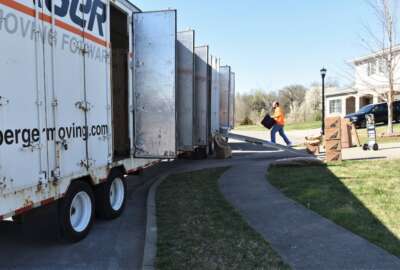Another possible challenge for DoD’s $18B moving contract: No movers
DoD's overhaul of its system to move servicemembers' goods from place to place was supposed to have been implemented by now. But so far, no major moving companies...
For the moment, the Pentagon’s transition to a new multibillion dollar contract for household goods moves is being held up by IT integration issues between Defense Department systems and those of its prime contractor. But the long-planned overhaul faces a much more dire challenge: the possibility that almost no one in the current moving industry will take part in the new arrangement.
Movers say that’s not because they don’t want to. For them, up until now, military moves have been good business. But they argue a combination of drastically lower rates under the new contract and bureaucratic complexities stemming from the Service Contract Act would make almost every military move a money-losing proposition.
“I’m in contact with the top seven movers in the nation, and there are no major movers signed up,” said Bill Lovejoy, the president of Republic Moving and Storage, who also serves as the chairman of the American Trucking Association’s Moving and Storage Conference. “They’ve signed up a lot of these little two-men-and-a-truck operations and internet movers, but these people have never done a military job in their life. Their warehouses are not military approved. And we’re going to trust them with the fate of moves for the military? You’re going to have chaos if that actually comes to pass, and I’m not just saying that to protect my own.”
U.S. Transportation Command’s (TRANSCOM) new Global Household Goods (GHC) contract has long been meant to change almost everything about how the military interacts with the moving industry. Rather than contracting directly with companies on a move-by-move basis, the new construct will turn the management of all household goods shipment over to a single company — HomeSafe Alliance — which will then subcontract the work to individual movers.
Matt Dolan, HomeSafe’s president, acknowledged that persuading DoD’s existing movers to sign on as subcontractors hasn’t been easy.
“I’ve got a lot of work to do to convince them,” he said in an interview with Federal News Network. “I don’t think the whole story has been told, but I think the one thing that’s definite is that this is going forward. TRANSCOM is committed, and we’re committed. Compensation will always be an issue, but TRANSCOM has been a great partner and there are methods to take that into account. I have great friends in industry who give me their straight feelings on it, and I don’t deny any of it. But we think we’ll be successful.”
But the established players in the military moving industry say their calculus is fairly straightforward: The rates HomeSafe currently plans to pay them are substantially lower than what they’re currently receiving from DoD and other customers. So even for movers who’ve long focused on the military market, the new system simply isn’t economically viable.
“It’s not that we’re going to make less money, it’s that we’re going to lose money,” Tim Helenthal, the chairman and CEO of National Van Lines told Federal News Network. “We’re trying to get that across.”
Helenthal said the rates HomeSafe is offering to moving companies are 20%-to-25% lower than what they were being paid before the COVID-19 pandemic, and before the industry’s costs increased significantly.
“HomeSafe’s pricing was bid in 2019, and we’ve seen a lot of inflation in our industry. As an example, prior to the pandemic, one of our households goods trailers cost about $65,000. It’s about $110,000 now,” he said. “Our labor has increased substantially, our packaging materials have increased substantially. We’d be paid less than we were being paid in 2019, and then you add on all these costs, and there’s just not enough dollars.”
Helenthal said the industry is currently trying to persuade Congress to order a Government Accountability Office analysis to independently determine whether any company can turn a profit based on HomeSafe’s rates. So far, that hasn’t happened.
Service Contract Act complications
Another major complication for movers: Under the GHC contract, they’ll need to comply with the Service Contract Act (SCA) — something they’ve never had to do before, and that they argue is fundamentally incompatible with the way the moving industry operates.
The SCA is a regular feature of government contracts for services, and, in its simplest terms, dictates that government contractors and subcontractors pay their workers hourly “prevailing” wages appropriate to whatever local market they’re working in and the work they’re performing. Those wages are set by the Labor Department and published in contract solicitations.
But the 1965 statute also includes a carve-out for the transportation industry, which has long set its rates based on published tariffs. That’s how the household goods moving industry works now: Companies charge the government and the rest of their customers a predetermined rate for moving a certain number of pounds from one place to another, and drivers and other employees earn a percentage of that amount as independent contractors.
“For forklift workers and warehousemen, it’s doable, because they’re already hourly employees. When you get to the owner-operator drivers, that’s when the system goes haywire,” said Oded Carmi, the president of DN Van Lines who also heads the Massachusetts Movers Association. “We can’t figure out a way to stay in compliance with the SCA. The drivers are independent businesspeople. They don’t want to work for us on an hourly basis, and we can’t treat them in the same way that they’ve been treated under these new SCA requirements.”
HomeSafe’s Dolan disputes the “chaos” prediction. He said that although the government, not HomeSafe, made the decision to structure the contract in a way that implicates the SCA, his company thinks the model is perfectly workable. Earlier this month, HomeSafe began publishing some rudimentary resources, including a one-page fact sheet, to help moving companies prepare for the new approach.
“I think we all need to step back and review what the SCA is, because there are owner-operators doing work in federal markets [where the SCA applies] now,” he said. “Our goal would be not to harm owner-operators or to move away from the owner-operator model, and just to comply with the SCA.”
But movers say that apart from HomeSafe’s fact sheet, no one from the company or TRANSCOM has done much to help them navigate their new role as would-be service contractors without landing themselves in legal jeopardy.
National Van Lines’ Helenthal argued the new model is fundamentally at odds with how the broader industry operates because drivers are almost always carrying a mix of military and non-military shipments on their trucks. Under GHC, movers would have to find ways to simultaneously pay them the hourly rates the SCA demands while also compensating them with a cut of the tariffs that govern all other moves.
He said the complexity involved in blending the two models likely makes GHC untenable for most long-distance movers, even though DoD makes up 20% of the domestic moving market.
“That means 80% are non-military shipments, so four-out-of-five shipments aren’t military. So if our driver goes and picks up a military shipment today, we have to pay hourly wages for every hour they’re on duty. That’s fine, but if tomorrow, I send them up to Milwaukee to go pick up a non-military move, I have to pay the hourly wages as long as that military shipment is still on his truck,” he said. “What really gets difficult then is he might take two or three other shipments, he might have to go over to Madison, adding hours to what we have to pay him out of the money that we collect for that one military shipment. There’s just not enough money to cover that.”
Companies shifting business strategies
Even though DoD makes up a minority of the overall domestic moving market, there are some companies who’ve deliberately focused their businesses on developing expertise in military moves. Although there are more than 800 firms who are involved in DoD’s current household goods process, TRANSCOM only interacts directly with about a few dozen of them — most of whom serve as agents who help consolidate shipments, who serve as large-scale transportation providers, or some combination of the two.
But the move to GHC has many of those military-focused moving companies drastically rethinking their business models.
Republic Moving and Storage’s Lovejoy said he’d recently tripled his marketing budget to search for leads on companies and individuals who need moving services so that Republic can reduce its reliance on the huge military moving market in San Diego, where his firm is based.
“We have no choice. I told my people we need to replace the storage we have here and at least have options,” he said. “TRANSCOM takes that as a threat, but it’s not as though we don’t want to do the work. I’m a military mover. That’s 70% of what I do, but I have to be smart about my future. And if the SCA is part of this, then most quality movers will not opt in because it’s too risky to get caught being out of compliance and the fines that might come with not paying correctly.”
And DN Van Lines’ Carmi said his company has started spending money to advertise its services directly to military members, effectively working around the new system.
Under the military’s personally-procured move (PPM) program, service members are allowed to book and manage their own moves as private individuals and then be reimbursed at 100% of the cost of what DoD would otherwise have spent on their behalf.
“We 100% believe that there’s going to be a growth in the PPM market,” he said. “We’re basically saying, ‘Hey, we’re a military-approved moving company, we’ve been doing this for a long time, come work with us directly. There’s actually some efficiencies we can create in that direct-to-consumer relationship because we’re not bound by DoD’s required delivery dates. So I can go to you and say, ‘Hey, rather than having your shipment delivered in two weeks, I can deliver it to you in a month but I can give you a price savings.’ And you might decide that works well for you.”
HomeSafe and TRANSCOM still optimistic
HomeSafe’s Dolan said he can’t speak to any company’s profitability analysis, though he understands their concerns, having formerly served as an executive at a large van line.
He said that although the prices his company is offering are lower than what moving firms are accustomed to, they’re fair, and that HomeSafe tailored them to individual markets while taking into account SCA labor rates.
“We’ve had negotiations with TRANSCOM to adjust for the inflation that’s occurred. And there’s no doubt that in the current program, there’s significantly more revenue available to the movers than what we’re going to be able to provide [under GHC]. But we still think it’s compensatory — people can make money on this program,” he said. “We looked at the work that’s going out this winter, and we’re going to be pretty in line with the standard awards that are going out, at least during the non-peak season. We’re going to continue to refine these rates every year, and we’ll bring those adjustments to the street.”
Ken Brennan, TRANSCOM’s director of acquisition, said DoD is still confident the GHC model will be effective, and that enough movers will participate once the transition to the new contract begins.
“We always will be able to evaluate how moves are allocated,” he told reporters during a December roundtable. “We are a large part of the moving market and trying to drive that. But we also think that there is capacity out there that has never done business with the DoD, and that HomeSafe will be able to take advantage of this model and work within the parameters of the contract to get subcontractors lined up to execute this.”
Dolan said HomeSafe is doing all it can to preserve the relationships DoD already has with moving companies, but that his firm may well need to look at alternatives to those companies if not enough sign on.
“I’m not committed to any model that doesn’t help me take care of military members and do the best job I can, so if someone has an alternative type of capacity to move shipments that makes sense and complies with the rules, absolutely, I will be using those. I can’t not use them,” he said. “If the right thing for a military member is not to have a 53-foot trailer pull up in his yard, but to have a container that can be delivered, yes. If the right answer is to deliver a wooden lift van that gets moved, yes. And if there’s ways I don’t even know about yet that make sense, yes. We’re not going to be constrained by the current model just because it’s been there for for a long period of time. But in no way does that change the van line, which provides so much for those agents and drivers.”
But Republic’s Lovejoy predicted that experimenting with alternative models wouldn’t end well. Military movers, he said, need expertise in the market and “soft skills” to manage members’ expectations.
He said his company had tried other methods too, like transporting some shipments by rail or freight, but quickly abandoned them.
“We tried rail service back in the early 2000s, and it was a nightmare. We had so many shipments screwed up. We tried it for about six months, and then gave up,” he said. “I’ve never figured out how you can use [alternative methods] at scale and do a good job. You’ll make it work, maybe, but you wouldn’t do a good job with it.”
Answers on IT integration coming by this week
HomeSafe and TRANSCOM’s latest round of testing on IT integration issues are currently scheduled to be wrapped up by the end of this week.
If the results of those tests prove satisfactory, the plan is to begin phasing-in the new GHC construct by starting with simpler, short-distance moves.
It’s possible that approach could entice some existing movers to dip their toes into GHC.
“As the work comes in, we’re going to evaluate everything on a case-by-case basis. If there’s a shipment that we can make money on, we’ll do it,” Carmi said. “We’re not anti-GHC; we’re just anti-losing money. And those short-distance moves do seem be the only area where there’s an ability to make some kind of profit. The further the shipment goes, the less profitable it is based on the current rate structure.”
Dolan said HomeSafe is still in discussions with several major van lines and moving agents, and is confident that some of them will eventually sign on as subcontractors.
HomeSafe, however, declined to identify any moving companies who have signed onto GHC, and was not able to point Federal News Network toward any firms who would be willing to speak positively about the new structure.
Dolan said he views the challenge as largely a change management problem, and that many of the industry’s existing players will eventually sign up.
“I think when I can demonstrate to people that for no cost of sales, with the simplicity of use of our IT, having it be simpler to build their shipments … we can give them full loads and return tonnage and all those kinds of things, including predictability on where their shipments will be coming from every single week. We think that provides value. Maybe change is hard, but we think the industry will eventually come along.”
Nearly Useless Factoid
By: Daisy Thornton
Elected officials in Kentucky must swear, as part of their oath of office, that they have never “fought a duel with deadly weapons,” nor have they participated in one in any way. It’s the only state in the U.S. with such an oath.
Source: Louisville Courier-Journal
Copyright © 2025 Federal News Network. All rights reserved. This website is not intended for users located within the European Economic Area.
Jared Serbu is deputy editor of Federal News Network and reports on the Defense Department’s contracting, legislative, workforce and IT issues.
Follow @jserbuWFED






